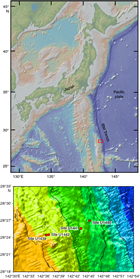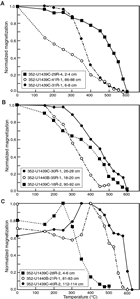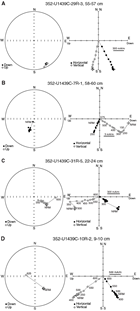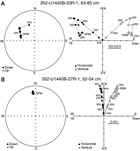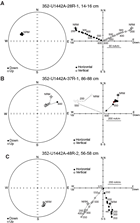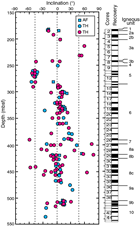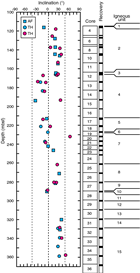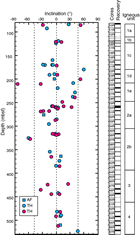Reagan, M.K., Pearce, J.A., Petronotis, K., and the Expedition 352 Scientists
Proceedings of the International Ocean Discovery Program Volume 352
publications.iodp.org
https://doi.org/10.14379/iodp.proc.352.202.2018
Data report: paleomagnetic direction measurements on Expedition 352 igneous core samples1
William W. Sager,2 Rachel W. Clark,3 and Claire Carvallo4
Keywords: International Ocean Discovery Program, IODP, JOIDES Resolution, Expedition 352, Site U1439, Site U1440, Site U1441, Site U1442, Izu-Bonin-Mariana fore arc, paleomagnetism, boninite, fore-arc basalt
MS 352-202: Received 16 May 2017 · Accepted 21 December 2017 · Published 10 April 2018
Abstract
Paleomagnetic measurements on International Ocean Discovery Program Expedition 352 basalt samples were undertaken to augment work done on board the R/V JOIDES Resolution during the expedition. A total of 177 new samples were measured using thermal demagnetization experiments with the goal of determining paleomagnetic inclinations from samples for tectonic studies. It was possible to estimate a characteristic remanent magnetization direction from 96% of the measured samples. New data were similar to those of the Expedition reports, with a large range of natural remanent magnetization values and variable demagnetization behaviors, both implying magnetic carriers with a variety of compositions. Paleoinclination values generally matched those found previously, with many having low values indicative of formation near the Equator.
Introduction
To investigate the origin of the Izu-Bonin-Mariana (IBM) outer arc, International Ocean Discovery Program (IODP) Expedition 352 cored igneous rocks at four locations along a short transect at approximately 28.4°N, 142.6°–142.8°E (see the Expedition 352 summary chapter [Reagan et al., 2015b]). The objective was to core two offset sections of igneous rock that together form a fore-arc succession from fore-arc basalts (base) to boninite lavas (top). This section is thought to represent the earliest IBM crust and to hold clues about the tectonic and magmatic formation of the arc. Tectonic and paleomagnetic studies have concluded that the IBM arc formed near the Equator during the Eocene epoch and subsequently drifted northward to its present location (Hall et al., 1995). We made paleomagnetic measurements on igneous samples from these sites to provide clues about the tectonic evolution of the cored sections. It is well known that igneous rocks have excellent potential for recording the magnetic field at the time they cooled. Although rotary cores cannot provide azimuthal orientation, measured paleomagnetic inclinations from drill cores can provide useful information about the paleolatitude of formation and subsequent tectonic disturbances, such as faulting.
During Expedition 352, paleomagnetic measurements were made on 173 igneous samples (see the Site U1439, Site U1440, Site U1441, and Site U1442 chapters [Reagan et al., 2015c, 2015d, 2015e, 2015f]). During subsequent shore-based studies, an additional 177 samples were measured. In this report, we detail the measurements and results from the shore-based work. For completeness, we provide data tables that include results from both ship- and shore-based measurements.
Drill sites
From west to east on the transect, the drill sites are IODP Sites U1439 and U1442 on the upslope end and IODP Sites U1441 and U1440 on the downslope end (Figure F1). Hole U1439C penetrated ~360 m of igneous rock in Cores 352-U1439C-2R through 45R. These rocks consist of boninite lavas in Cores 2R through 36R and evolved lavas at the bottom of the hole in Cores 37R through 45R (see the Site U1439 chapter [Reagan et al., 2015c]). Nearby Hole U1442A cored ~440 m of boninite lavas in Cores 352-U1442A-10R through 57R. Although some boninite lavas were recovered in both units, hyaloclastite was the dominant lithology recovered in Cores 352-U1442A-29R through 34R and 44R through 50R (see the Site U1442 chapter [Reagan et al., 2015f]). At the trench end of the transect, Hole U1440B penetrated ~260 m through extrusive fore-arc basalt lavas (Cores 352-U1440B-4R through 24R), a transition between extrusive lavas and dikes (Cores 25R through 31R), and ended in dolerite dikes (Cores 32R through 36R) (see the Site U1440 chapter [Reagan et al., 2015d]). Hole U1441A cored through an igneous section ~113 m in length. Slightly more than half of that section consists of breccia and the rest consists of fore-arc basalts (see the Site U1441 chapter [Reagan et al., 2015e]).
Methods
Core recovery rates were generally low during Expedition 352, and this factor affected the number and location of samples taken for this study. Longer core pieces are preferred for sampling because one can be certain that they maintained vertical orientation during coring and recovery. Owing to the low recovery, we had to use small pieces in many cores but only sampled pieces with lengths approximately equal to the core diameter (8 cm) or greater. Vertical orientation is determined from the vertical side of the core, so the only pieces sampled were those with at least one such side preserved. In many cores, these samples were few. Cubes with 2 cm sides (8 cm3 volume) were cut with the two-blade saw in the R/V JOIDES Resolution core laboratory. In total, we gathered 177 samples from Expedition 352 cores with 115 from Hole U1439C, 25 from Hole U1440B, and 37 from Hole U1442A. This uneven distribution was dictated by the greater recovery in Hole U1439C compared with the others. Recovery was so poor in Hole U1441A that no additional samples were taken for shore-based study. Although no new measurements were made for this hole, the shipboard results are given here so that all paleomagnetic direction data are presented in one place.
Onshore measurements were made in the University of Houston paleomagnetic laboratory. Magnetization measurements were made with an Agico JR-6A spinner magnetometer in a shielded room. The sensitivity limit of this instrument is ~0.5 × 10−6 A/m. Thermal demagnetization was used exclusively on the shore-measured samples because measurements during Expedition 352 indicated that alternating field (AF) demagnetization was not as reliable in isolating the desired characteristic remanent magnetization (ChRM), probably because many samples have relatively high magnetic coercivity (see Paleomagnetism in the Site U1442 chapter [Reagan et al., 2015f]). Stepwise thermal demagnetizations were carried out with a Schoenstedt TSD-1 oven located in a shielded room. After the initial natural remanent magnetization (NRM) was measured, subsequent measurements were made after thermal demagnetization at 50°C steps from 150° to 400° or 450°C and 25°C steps up to 550°–600°C. Demagnetization of a few samples was discontinued before 600°C if the sample became too weak to be reliably measured or the high-temperature measurements were deemed erratic. A few samples were discontinued because they expanded at 550°C or above and would no longer fit in the sample holder. Most samples were measured up to a high temperature of 550°–625°C.
Samples on the JOIDES Resolution were measured with the same type of spinner magnetometer but were not in a shielded environment. Shipboard AF demagnetization was done with a D-Tech Model D-2000 demagnetizer, whereas thermal demagnetization was accomplished with an ASC Model TD-48SC oven. Additional measurement details are given in the Expedition 352 methods chapter (Reagan et al., 2015a).
All direction measurements were analyzed using Agico Remasoft software, which makes plots of the magnetization measurements and does principal component analysis (PCA) (Kirschvink, 1980). Plots of the vector endpoint on a stereonet, normalized magnetization at different demagnetization steps, and orthogonal vector (Zijderveld) plots showing the vector endpoints projected on two orthogonal planes were made for each sample to aid analysis. For typical samples, one observes an overprint removed at low-temperature steps, revealing the ChRM, acquired at the time of initial rock cooling at high steps (e.g., Butler, 1992). We looked for consistent endpoints on the stereonet and linear segments pointing toward the origin on the orthogonal vector plot to signify a stable ChRM. The direction of the ChRM was calculated using PCA for a number of consistent measurements at consecutive temperature steps. For the samples measured on shore, the minimum number of steps used was 4 for one sample, but 5–7 steps is common and sometimes as many as 12–13 consistent steps were used. The PCA calculation produces a measure of angular dispersion of the measurements, called maximum angular deviation (MAD) (Kirschvink, 1980). Larger MAD values indicate greater scatter. Although there is no consensus view on a maximum reliable MAD value, we consider samples with MAD > 10° to be unreliable direction indicators. All reported PCA directions were calculated without anchoring the vector to the origin because the unanchored calculation is considered more representative of the ChRM.
Results
In general, study measurements produced data with excellent internal consistency. Only a few samples (7 total) produced erratic, unreliable data (Tables T1, T2, T3, and T4). This was fewer than the unreliable data from the shipboard study (28 total) mainly because AF demagnetization was tried on the ship and proved somewhat unreliable at producing consistent results.
NRM magnitudes varied widely, from a low of 7.8 × 10−5 to 20.6 A/m, although most were in the middle of that range, from a few tens to hundreds of milliamperes per meter (×10−3 A/m). Generally, NRM values were low (typically <1 A/m) for the boninite and andesite rocks from Holes U1439C and U1442A (Tables T1, T4) and higher (typically 1–20 A/m) for basaltic rocks recovered from Holes U1440B and U1441A (Tables T2, T3).
T1. Hole U1439C discrete sample paleomagnetic data. Download table in CSV format.
T2. Hole U1440B discrete sample paleomagnetic data. Download table in CSV format.
T3. Hole U1441A discrete sample paleomagnetic data. Download table in CSV format.
T4. Hole U1442A discrete sample paleomagnetic data. Download table in CSV format.
Normalized demagnetization curves showed several typical behaviors that imply varied compositions or grain sizes of magnetic grains (Figure F2). Some plots showed nearly linear decay of the magnetization at successively higher demagnetization temperatures, indicating a wide distribution of magnetic grain blocking temperatures (Sample 352-U1439C-41R-1, 86–88 cm). This behavior may indicate titanomagnetite with variable amounts of Ti substituting for Fe in the crystal lattice (e.g., O’Reilly, 1976). Some plots displayed little demagnetization at low temperatures followed by a decrease at higher temperatures (Sample 352-U1439C-30R-1, 26–28 cm). In some samples, this decrease was quite steep above 500°C, indicating nearly pure magnetite (Samples 352-U1439C-29R-4, 2–4 cm, and 40R-2, 112–114 cm). A behavior intermediate between these two types was also noted, in which the magnetization decreased little at low and high temperature steps, but much of the decay occurred at intermediate steps (Sample 352-U1439C-31R-1, 6–8 cm). This distribution implies that most magnetic grains have intermediate blocking temperatures. In some samples, the division into sections of low and high slope was not prominent, so the demagnetization curve was convex upward, indicating a wide distribution of blocking temperatures but with a dominance of high-temperature grains (Sample 352-U1439C-29R-4, 2–4 cm). A completely different pattern was noted for about 30% of the samples, in which the magnetization increased with increasing temperature for some range of middle temperatures, typically 250°–300°C to 350°–400°C (Samples 352-U1439C-28R-2, 4–6 cm, 40R-2, 112–114 cm, and 352-U1440B-21R-1, 81–83 cm). Such curves peak in the middle and suffer a sharp decrease at high temperatures. This is typical of partial self-reversal (Doubrovine and Tarduno, 2004, 2005), which occurs when one of the magnetic sublattices of the mineral grains record the magnetic field in the opposite direction of the ambient field. In such samples, moderate temperatures remove the contribution from this lattice, allowing the magnetization strength to increase before higher temperatures cause the magnetization to decay. The samples with partial self-reversal behavior were scattered throughout the cored units rather than concentrated in any section.
Sample magnetization directions were usually internally consistent, often producing ChRM estimates with low scatter (low MAD values) (Figures F3, F4, F5). In addition, most samples (~77%) showed little magnetic overprint. This is somewhat unusual for samples cored by the JOIDES Resolution because the strong magnetic fields of the drill string often impart an isothermal remanent magnetization (IRM) to the samples that pass through it (Audunsson and Levi, 1989; Fuller et al., 1998; Roberts et al., 1996; Acton et al., 2002). This spurious magnetization is often recognized because it appears along the axis of the drill string (i.e., nearly vertical). Only about 16% of measured samples had downward-pointing overprints. The infrequency of strong vertical overprints on Expedition 352 samples is probably a consequence of the fact that many samples have high magnetic coercivity (see the Site U1442 chapter [Reagan et al., 2015f]), so they are resistant to being remagnetized. Directional measurements at all sites found some samples with partial self-reversal behavior, which is observed as the magnetization vector first shrinks, then grows, then shrinks again (Figure F4B). Stereonet plots show little scatter (Figures F3D, F4B, F5C), indicating that this behavior had negligible effect on the ChRM direction. Moreover, there is no evident difference between the directions of these and samples that do not display partial self-reversal.
Plotting the ship- and shore-based results together versus depth (Figures F6, F7, F8) shows that the new results agree well with the those from the ship. In Hole U1439C, new data show two zones of high inclinations (approximately ±45°) at ~210–230 and ~240–290 meters below seafloor (mbsf). The lower of the two was noted in shipboard measurements (see the Site U1439 chapter [Reagan et al., 2015c]) and is confirmed by the new samples. These high inclinations are similar in value to the present-day field, so they may indicate recent remagnetization. Most samples in the rest of the section have low inclination values, with absolute values <30° (Figure F6). These samples probably indicate the magnetic field near the Equator that was recorded at the time of crustal formation. Notably, there are many samples with scattered, higher inclinations in the faulted section between ~375 and 455 mbsf. These values may indicate tectonic disturbance.
Data from shore-based analyses from Hole U1440B plot close to those of prior analyses from the JOIDES Resolution (Figure F7). Most samples have inclination absolute values <30°, which is indicative of low-latitude formation. The inclinations display a sinuous pattern, oscillating back and forth from zero, which may be a recording of near-equatorial paleosecular variation. Values from the lowest cores (352-U1440B-31R through 35R) are nearly the same, which supports the idea that these samples are from vertical dikes.
Inclinations from Hole U1442A show similar characteristics to those from Hole U1439C: most samples have absolute values <30°, but there are zones of scattered samples with higher values (Figure F8). Some of these outlier values are near faults, so they may have a tectonic cause.
Addendum
Data from additional samples
We found that nine samples taken during Expedition 352 had not been measured and reported. Data from these samples is given in Table T5 for completeness. Sample 352-U1439C-20R-2, 42–44 cm, had been thermally demagnetized up to 250°C, but the full demagnetization experiment was not completed. Measurements on this sample were continued with thermal demagnetization up to 550°C following the procedure used for samples previously reported. The other eight samples (five from Hole U1439C, one from Hole U1440B, and two from Hole U1442A) had not been measured at all because they were irregular in size or shape and would not fit the magnetometer sample holder. These samples were placed in 2.5 cm diameter cylindrical molds, which were then filled with plaster. Because of the plaster coatings, AF demagnetization was used to isolate the characteristic remanence following the procedure and steps used for samples previously reported. Demagnetization step data for each sample were analyzed in the same manner as for other samples from this project. Of the nine samples measured, six gave reliable ChRM directions and three proved unreliable.
T5. Additional discrete sample paleomagnetic data. Download table in CSV format.
Acknowledgments
This research used samples and data provided by the International Ocean Discovery Program (IODP), which is supported in part by the National Science Foundation. The work reported here was supported by a PEA grant from the US Science Support Program. The authors thank the reviewer for helpful comments.
References
Acton, G.D., Okada, M., Clement, B.M., Lund, S.P., and Williams, T., 2002. Paleomagnetic overprints in ocean sediment cores and their relationship to shear deformation caused by piston coring. Journal of Geophysical Research: Solid Earth, 107(B4):2067–2081. http://dx.doi.org/10.1029/2001JB000518
Audunsson, H., and Levi, S., 1989. Drilling-induced remanent magnetization in basalt drill cores. Geophysical Journal International, 98(3):613–622. http://dx.doi.org/10.1111/j.1365-246X.1989.tb02294.x
Butler, R.F., 1992. Paleomagnetism: Magnetic Domains to Geologic Terranes: Boston (Blackwell Science Publishing).
Doubrovine, P.V., and Tarduno, J.A., 2004. Self-reversed magnetization carried by titanomaghemite in oceanic basalts. Earth and Planetary Science Letters, 222(3–4):959–969. https://doi.org/10.1016/j.epsl.2004.04.009
Doubrovine, P.V., and Tarduno, J.A., 2005. On the compositional field of self-reversing titanomaghemite: constraints from Deep Sea Drilling Project Site 307. Journal of Geophysical Research: Solid Earth, 110(B11):B11104. http://dx.doi.org/10.1029/2005JB003865
Fuller, M., Hastedt, M., and Herr, B., 1998. Coring-induced magnetization of recovered sediment. In Weaver, P.P.E., Schmincke, H.-U., Firth, J.V., and Duffield, W. (Eds.), Proceedings of the Ocean Drilling Program, Scientific Results, 157: College Station, TX (Ocean Drilling Program), 47–56. https://doi.org/10.2973/odp.proc.sr.157.103.1998
Hall, R., Fuller, M., Ali, J.R., and Anderson, C.D., 1995. The Philippine Sea plate: magnetism and reconstructions. In Taylor, B., and Natland, J. (Eds.), Active Margins and Marginal Basins of the Western Pacific. Geophysical Monograph, 88:371–404. http://dx.doi.org/10.1029/GM088p0371
Kirschvink, J.L., 1980. The least-squares line and plane and the analysis of palaeomagnetic data. Geophysical Journal of the Royal Astronomical Society, 62(3):699–718. https://doi.org/10.1111/j.1365-246X.1980.tb02601.x
O’Reilly, W., 1976. Magnetic minerals in the crust of the Earth. Reports on Progress in Physics, 39(9):857–908. http://dx.doi.org/10.1088/0034-4885/39/9/002
Reagan, M.K., Pearce, J.A., Petronotis, K., Almeev, R., Avery, A.A., Carvallo, C., Chapman, T., Christeson, G.L., Ferré, E.C., Godard, M., Heaton, D.E., Kirchenbaur, M., Kurz, W., Kutterolf, S., Li, H.Y., Li, Y., Michibayashi, K., Morgan, S., Nelson, W.R., Prytulak, J., Python, M., Robertson, A.H.F., Ryan, J.G., Sager, W.W., Sakuyama, T., Shervais, J.W., Shimizu, K., and Whattam, S.A., 2015a. Expedition 352 methods. In Reagan, M.K., Pearce, J.A., Petronotis, K., and the Expedition 352 Scientists, Izu-Bonin-Mariana Fore Arc. Proceedings of the International Ocean Discovery Program, 352: College Station, TX (International Ocean Discovery Program). https://doi.org/10.14379/iodp.proc.352.102.2015
Reagan, M.K., Pearce, J.A., Petronotis, K., Almeev, R., Avery, A.A., Carvallo, C., Chapman, T., Christeson, G.L., Ferré, E.C., Godard, M., Heaton, D.E., Kirchenbaur, M., Kurz, W., Kutterolf, S., Li, H.Y., Li, Y., Michibayashi, K., Morgan, S., Nelson, W.R., Prytulak, J., Python, M., Robertson, A.H.F., Ryan, J.G., Sager, W.W., Sakuyama, T., Shervais, J.W., Shimizu, K., and Whattam, S.A., 2015b. Expedition 352 summary. In Reagan, M.K., Pearce, J.A., Petronotis, K., and the Expedition 352 Scientists, Izu-Bonin-Mariana Fore Arc. Proceedings of the International Ocean Discovery Program, 352: College Station, TX (International Ocean Discovery Program). https://doi.org/10.14379/iodp.proc.352.101.2015
Reagan, M.K., Pearce, J.A., Petronotis, K., Almeev, R., Avery, A.A., Carvallo, C., Chapman, T., Christeson, G.L., Ferré, E.C., Godard, M., Heaton, D.E., Kirchenbaur, M., Kurz, W., Kutterolf, S., Li, H.Y., Li, Y., Michibayashi, K., Morgan, S., Nelson, W.R., Prytulak, J., Python, M., Robertson, A.H.F., Ryan, J.G., Sager, W.W., Sakuyama, T., Shervais, J.W., Shimizu, K., and Whattam, S.A., 2015c. Site U1439. In Reagan, M.K., Pearce, J.A., Petronotis, K., and the Expedition 352 Scientists, Izu-Bonin-Mariana Fore Arc. Proceedings of the International Ocean Discovery Program, 352: College Station, TX (International Ocean Discovery Program). https://doi.org/10.14379/iodp.proc.352.103.2015
Reagan, M.K., Pearce, J.A., Petronotis, K., Almeev, R., Avery, A.A., Carvallo, C., Chapman, T., Christeson, G.L., Ferré, E.C., Godard, M., Heaton, D.E., Kirchenbaur, M., Kurz, W., Kutterolf, S., Li, H.Y., Li, Y., Michibayashi, K., Morgan, S., Nelson, W.R., Prytulak, J., Python, M., Robertson, A.H.F., Ryan, J.G., Sager, W.W., Sakuyama, T., Shervais, J.W., Shimizu, K., and Whattam, S.A., 2015d. Site U1440. In Reagan, M.K., Pearce, J.A., Petronotis, K., and the Expedition 352 Scientists, Izu-Bonin-Mariana Fore Arc. Proceedings of the International Ocean Discovery Program, 352: College Station, TX (International Ocean Discovery Program). https://doi.org/10.14379/iodp.proc.352.104.2015
Reagan, M.K., Pearce, J.A., Petronotis, K., Almeev, R., Avery, A.A., Carvallo, C., Chapman, T., Christeson, G.L., Ferré, E.C., Godard, M., Heaton, D.E., Kirchenbaur, M., Kurz, W., Kutterolf, S., Li, H.Y., Li, Y., Michibayashi, K., Morgan, S., Nelson, W.R., Prytulak, J., Python, M., Robertson, A.H.F., Ryan, J.G., Sager, W.W., Sakuyama, T., Shervais, J.W., Shimizu, K., and Whattam, S.A., 2015e. Site U1441. In Reagan, M.K., Pearce, J.A., Petronotis, K., and the Expedition 352 Scientists, Izu-Bonin-Mariana Fore Arc. Proceedings of the International Ocean Discovery Program, 352: College Station, TX (International Ocean Discovery Program). https://doi.org/10.14379/iodp.proc.352.105.2015
Reagan, M.K., Pearce, J.A., Petronotis, K., Almeev, R., Avery, A.A., Carvallo, C., Chapman, T., Christeson, G.L., Ferré, E.C., Godard, M., Heaton, D.E., Kirchenbaur, M., Kurz, W., Kutterolf, S., Li, H.Y., Li, Y., Michibayashi, K., Morgan, S., Nelson, W.R., Prytulak, J., Python, M., Robertson, A.H.F., Ryan, J.G., Sager, W.W., Sakuyama, T., Shervais, J.W., Shimizu, K., and Whattam, S.A., 2015f. Site U1442. In Reagan, M.K., Pearce, J.A., Petronotis, K., and the Expedition 352 Scientists, Izu-Bonin-Mariana Fore Arc. Proceedings of the International Ocean Discovery Program, 352: College Station, TX (International Ocean Discovery Program). https://doi.org/10.14379/iodp.proc.352.106.2015
Roberts, A.P., Stoner, J.S., and Richter, C., 1996. Coring-induced magnetic overprints and limitations of the long-core paleomagnetic measurement technique: some observations from Leg 160, eastern Mediterranean Sea. In Emeis, K.-C., Robertson, A.H.F., Richter, C., et al., Proceedings of the Ocean Drilling Program, Initial Reports, 160: College Station, TX (Ocean Drilling Program), 497–505. https://doi.org/10.2973/odp.proc.ir.160.115.1996
1 Sager, W.W., Clark, R.W., and Carvallo, C., 2018. Data report: paleomagnetic direction measurements on Expedition 352 igneous core samples. In Reagan, M.K., Pearce, J.A., Petronotis, K.E., and the Expedition 352 Scientists, Izu-Bonin-Mariana Fore Arc. Proceedings of the International Ocean Discovery Program, 352: College Station, TX (International Ocean Discovery Program). https://doi.org/10.14379/iodp.proc.352.202.2018
2 Department of Earth and Atmospheric Sciences, University of Houston, USA. wwsager@uh.edu
3 Department of Geology, Bryn Mawr College, USA.
4 Institut de Minéralogie et de Physique des Milieux Condensés, Université Pierre et Marie Curie, France.
This work is distributed under the Creative Commons Attribution 4.0 International (CC BY 4.0) license. 
